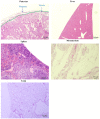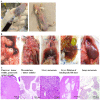Investigation into metastatic processes and the therapeutic effects of gemcitabine on human pancreatic cancer using an orthotopic SUIT-2 pancreatic cancer mouse model
- PMID: 29435042
- PMCID: PMC5778887
- DOI: 10.3892/ol.2017.7722
Investigation into metastatic processes and the therapeutic effects of gemcitabine on human pancreatic cancer using an orthotopic SUIT-2 pancreatic cancer mouse model
Abstract
Prognosis of pancreatic cancer is poor, thus the development of novel therapeutic drugs is necessary. During preclinical studies, appropriate models are essential for evaluating drug efficacy. The present study sought to determine the ideal pancreatic cancer mouse model for reliable preclinical testing. Such a model could accurately reflect human pancreatic cancer phenotypes and predict future clinical trial results. Systemic pathology analysis was performed in an orthotopic transplantation model to prepare model mice for use in preclinical studies, mimicking the progress of human pancreatic cancer. The location and the timing of inoculated cancer cell metastases, pathogenesis and cause of fatality were analyzed. Furthermore, the efficacy of gemcitabine, a key pancreatic cancer drug, was evaluated in this model where liver metastasis and peritoneal dissemination occur. Results indicated that the SUIT-2 orthotopic pancreatic cancer model was similar to the phenotypic sequential progression of human pancreatic cancer, with extra-pancreatic invasion, intra-peritoneal dissemination and other hematogenous organ metastases. Notably, survival was prolonged by administering gemcitabine to mice with metastasized pancreatic cancer. Furthermore, the detailed effects of gemcitabine on the primary tumor and metastatic tumor lesions were pathologically evaluated in mice. The present study indicated the model accurately depicted pancreatic cancer development and metastasis. Furthermore, the detailed effects of pancreatic cancer drugs on the primary tumor and on metastatic tumor lesions. We present this model as a potential new standard for new drug development in pancreatic cancer.
Keywords: chemotherapy; gemcitabine; metastasis; orthotopic mouse model; pancreatic cancer; pathology; survival prolongation effects.
Figures






References
-
- Okusaka T, Matsumura Y, Aoki K. New approaches for pancreatic cancer in Japan. Cancer Chemother Pharmacol. 2004;54(Suppl 1):S78–S82. - PubMed
-
- Burris HA, III, Moore MJ, Andersen J, Green MR, Rothenberg ML, Modiano MR, Cripps MC, Portenoy RK, Storniolo AM, Tarassoff P, et al. Improvements in survival and clinical benefit with gemcitabine as first-line therapy for patients with advanced pancreas cancer: A randomized trial. J Clin Oncol. 1997;15:2403–2413. doi: 10.1200/JCO.1997.15.6.2403. - DOI - PubMed
LinkOut - more resources
Full Text Sources
Other Literature Sources
